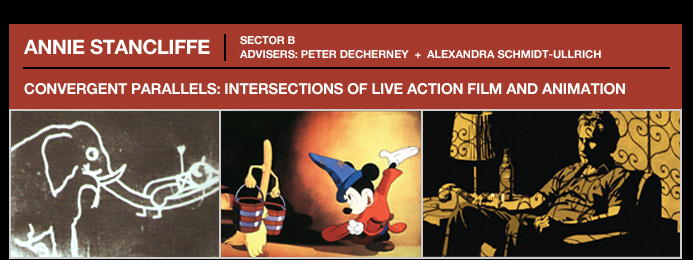
CONVERGENT PARALLELS: INTERSECTIONS OF LIVE ACTION FILM AND ANIMATION
As closely related forms of visual storytelling, live-action film and animation have a natural affinity toward interweaving onscreen. This project examines the visual and conceptual evolution of this intersection through analysis of production process, visual effects, and thematic elements of specific case studies dating from 1900 to 2009. The discussion is structured around three central frames of analysis: self-figuration of the animator, interpretations of realism, and virtuality of the screen. Early animators Emile Cohl, Winsor McCay, and Max Fleisher are discussed in relation to self-figuration and the explicit insertion of authorship through live-action segments. Chuck Jones’ Duck Amuck is examined as reflexively deconstructing the paradigms of cartoon aesthetics that evolved out of early animation. This visual differentiation between live-action and animation aesthetics is emphasized in Fantasia, Who Framed Roger Rabbit, and Waltz with Bashir to construct alternative interpretations of “realism” as depicted through animation. Finally, the advancement of computer animation technology is shown to complicate notions of filmic indexicality, allowing for the creation of animated virtual realms that lack any imprint of a real world referent. James Cameron’s Avatar represents the epitome of sophisticated imaging technology, employing live-action motion-capture to generate animated imagery and yield a seamless visual integration onscreen. Ultimately, synthesis of these case studies suggests that live-action intersects with animation first as means of self-figuration, then as a model for realism, and finally as a capture technique to generate images to be manipulated within an imagined virtual realm.
SECTOR B: Art and Culture of Seeing
ADVISORS: Peter Dechereny (ENGL/CINE) | Alexandra Schmidt-Ullrich (Professional)

 Visual Studies
Visual Studies